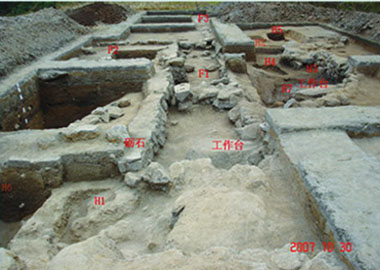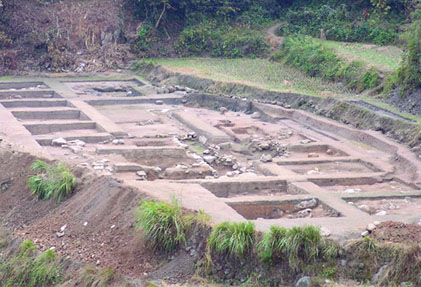The Hualin Papermaking Mill Site in Gao’an City
The Hualin site is located at Zhouling Village in the Hualin Resort in Gao’an City, Jiangxi Province. From October to December of 2009, the joint expedition of the Jiangxi Provincial Institute of Cultural Heritage and Archaeology and carried out a second excavation at the Hualin papermaking mill site. Altogether they exposed over 700m2.

The excavation uncovered seven water wheels for husking bamboo and hemp at both sides of the Shinaotou Stream, a bamboo-hemp- soaking pit, a clay pipe, and a lime kiln at the Fuzhimiao mill, a bamboo-hemp-soaking pit and a paper-forming house of the Yuan dynasty; a bamboo-hemp-soaking pit, a lime kiln, a bamboo-hemp- boiling surface, a drying and lime-mixing platform, a lime storage area, and sand-trashing pit, which are related to paper making, of the Ming dynasty. In addition, it turned up a dust fence, a water sewage, postholes, and pillar stones, which denote some structures. The bamboo-hemp- soaking pit H3 of the Yuan dynasty, which preserves merely a small part of its original form, appears to be an expanded structure of the Song dynasty pit H7. The Ming dynasty bamboo-hemp-soaking pit is a rectangular stone-lined pool, 11.45m long, 1.53m wide, and 0.5m deep, which is divided into two sections by a stone wall, but connected by a water ditch.

No.1 water wheel is laid out in south-north direction. The wheel pond, paved with stones, is rectangular, 2.7m long and 1.9m wide. Atop the two side walls are laid rectangular stone beams, which bear two sets of mortise-mortars. The artifacts from the bottom of the pond date it to the middle and late Ming dynasty. The seven wheels are structurally and dimensionally similar. But they vary in the position of wheel axle rests and the pounding heads. Altogether they fall into three categories: A. No.1 and No.3 each have one stone mortar and a stone slab with a din; B. No.2 drill has two stone mortars; C. Nos. 4-7 have two stone slabs each. Those that have stone slabs are meant for papermaking; Nos.1 and 3 drills could have been used for processing grains or paper pulp.

The Hualin site is one of the earliest papermaking mills found in China. The various structures of the Ming dynasty manifest an entire procedure of paper-making from bamboo felling through paper pulp, and illustrate the description of “fresh-bamboo-soaking pond” and “bamboo-boiling” in the Tiangong Kaiwu (Exploitation of the Works of Nature). All these shed new light into the papermaking techniques of southern China and the paper mills under the administration of the Xishan State Bureau of the Ming dynasty.
(Translated by Zhang Liangren)

